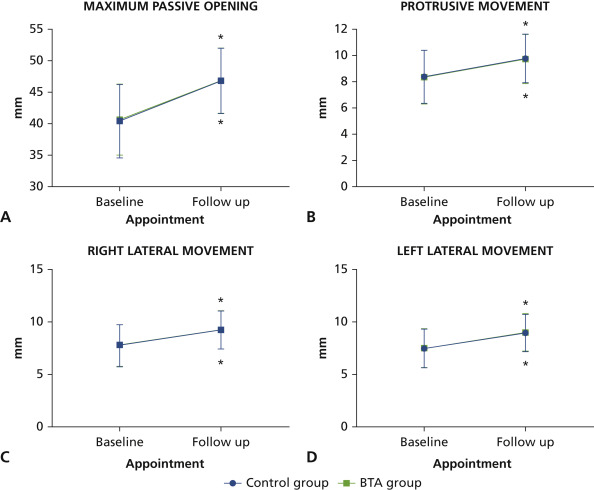Musculoskeletal conditions.
()
A comprehensive review of the treatment and management of myofascial pain syndrome.
Curr Pain Headache Rep. 2020; 24: 43
Diagnostic criteria for temporomandibular disorders (DC/TMD) for clinical and research applications: recommendations of the International RDC/TMD Consortium Network and Orofacial Pain Special Interest Group.
J Oral Facial Pain Headache. 2014; 28: 6-27
Expanding the taxonomy of the diagnostic criteria for temporomandibular disorders.
J Oral Rehabil. 2014; 41: 2-23
Temporomandibular joint and muscle disorder-type pain and comorbid pains in a national US sample.
J Orofac Pain. 2011; 25: 190-198
Travell and Simons Myofascial Pain and Dysfunction: The Trigger Point Manual.
2nd ed. Williams & Willkins,
1999
Botulinum toxin type A for the treatment of head and neck chronic myofascial pain syndrome: a systematic review and meta-analysis.
JADA. 2016; 147: 959-973.e1
History of botulinum toxin treatment in movement disorders.
Tremor Other Hyperkinet Mov (N Y). 2016; 6: 394
Botulinum neurotoxins: biology, pharmacology, and toxicology.
Pharmacol Rev. 2017; 69: 200-235
Botulinum toxin for myofascial pain syndromes in adults.
Cochrane Database Syst Rev. 2014; 2014
Management of temporomandibular disorders: concepts and controversies.
J Prosthet Dent. 1997; 77: 510-522
Declaration of Helsinki: ethical principles for medical research involving human subjects.
JAMA. 2013; 310: 2191-2194
Research diagnostic criteria for temporomandibular disorders: review, criteria, examinations and specifications, critique.
J Craniomandib Disord. 1992; 6: 301-355
Adaptación transcultural de los criterios diagnósticos para la investigación de los trastornos temporomandibulares (CDI/TTM).
Rev Fac Odontol Univ Antioq. 2013; 25: 11-25
Botulinum toxin: pharmacology and therapeutic roles in pain states.
Curr Pain Headache Rep. 2016; 20: 1-8
Botulinum toxin treatment of pain syndromes: an evidence based review.
Toxicon. 2018; 147: 120-128
Botulinum toxin therapy for temporomandibular joint disorders: a systematic review of randomized controlled trials.
Int J Oral Maxillofac Surg. 2015; 44: 1018-1026
Botulinum toxin in the management of temporomandibular disorders: a systematic review.
Br J Oral Maxillofac Surg. 2020; 58
Comparative efficacy and safety of skeletal muscle relaxants for spasticity and musculoskeletal conditions: a systematic review.
J Pain Symptom Manage. 2004; 28: 140-175
Evaluation of the impact of preoperative use of dexamethasone and cyclobenzaprine in surgical extraction of lower third molars on trismus by electromyographic analysis.
Oral Maxillofac Surg. 2019; 23: 395-405
Myofascial temporomandibular disorder.
Curr Rheumatol Rev. 2015; 12: 40-54
The use of botulinum toxin for the treatment of temporomandibular disorders: preliminary findings.
J Oral Maxillofac Surg. 1999; 57: 920-921
Treatment of localized and referred masticatory myofascial pain with botulinum toxin injection.
Toxins (Basel). 2020; 13: 6
Efficacy of botulinum toxin in treating myofascial pain in bruxers: a controlled placebo pilot study.
Cranio J Craniomandib Pract. 2008; 26: 126-135
Effect of botulinum toxin A in myofascial pain patients with or without functional disc displacement.
J Oral Maxillofac Surg. 2008; 66: 1644-1651
Efficacy and safety of botulinum toxin type a on persistentmyofascial pain: a randomized clinical trial.
Toxins (Basel). 2020; 12
Myofascial pain of the jaw muscles: comparison of short-term effectiveness of botulinum toxin injections and fascial manipulation technique.
Cranio J Craniomandib Pract. 2012; 30: 95-102
Effect of injection of botulinum toxin on decreasing the symptoms and signs of masticatory muscles in patients with temporomandibular dysfunction.
J Dent Res Dent Clin Dent Prospects. 2019; 13: 128-132
Effectiveness of botulinum toxin type A for the treatment of chronic masticatory myofascial pain: a case series.
JADA. 2017; 148: 33-39
The use of botulinum toxin-a in the treatment of muscular temporomandibular joint disorders.
J Stomatol Oral Maxillofac Surg. 2019; 120: 322-325
Efficacy of botulinum toxin type A for treatment of persistent myofascial TMD pain: a randomized, controlled, double-blind multicenter study.
Pain. 2011; 152: 1988-1996
Different antinociceptive effects of botulinum toxin type A in inflammatory and peripheral polyneuropathic rat models.
Eur J Pharmacol. 2009; 617: 48-53
Central origin of the antinociceptive action of botulinum toxin type A.
Pharmacol Biochem Behav. 2009; 94: 234-238
Botulinum toxin type A reduces pain supersensitivity in experimental diabetic neuropathy: bilateral effect after unilateral injection.
Eur J Pharmacol. 2010; 633: 10-14
Behavioral and immunohistochemical evidence for central antinociceptive activity of botulinum toxin A.
Neuroscience. 2011; 186: 201-207
Reduction of TRPV1 expression in the trigeminal system by botulinum neurotoxin type-A.
Neurobiol Dis. 2012; 48: 367-378
Involvement of substance P in the antinociceptive effect of botulinum toxin type A: evidence from knockout mice.
Neuroscience. 2017; 358: 137-145
Subcutaneous administration of botulinum toxin a reduces formalin-induced pain.
Pain. 2004; 107: 125-133
Sensitivity of embryonic rat dorsal root ganglia neurons to Clostridium botulinum neurotoxins.
Toxicon. 2000; 38: 245-258
Regulation of calcitonin gene-related peptide secretion from trigeminal nerve cells by botulinum toxin type A: implications for migraine therapy.
Headache. 2004; 44: 35-43
Synaptobrevin I mediates exocytosis of CGRP from sensory neurons and inhibition by botulinum toxins reflects their anti-nociceptive potential.
J Cell Sci. 2007; 120: 2864-2874
The effect of botulinum neurotoxin A on sciatic nerve injury−induced neuroimmunological changes in rat dorsal root ganglia and spinal cord.
Neuroscience. 2011; 175: 358-366
Botulinum toxin A increases analgesic effects of morphine, counters development of morphine tolerance and modulates glia activation and μ opioid receptor expression in neuropathic mice.
Brain Behav Immun. 2013; 32: 40-50
Comparison of the expression changes after botulinum toxin type a and minocycline administration in lipopolysaccharide-stimulated rat microglial and astroglial cultures.
Front Cell Infect Microbiol. 2017; 7


